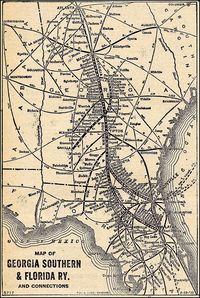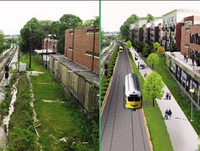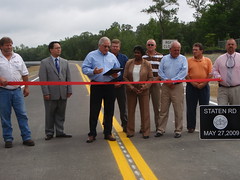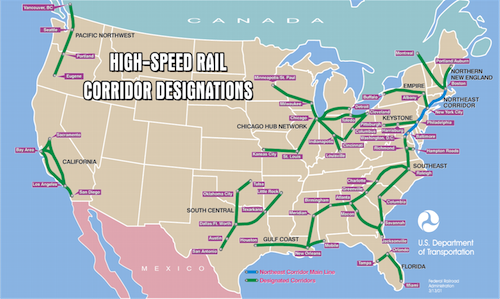Rain pouring through window, Nashville, Tennessee, 2 May 2010.
Meanwhile, upmoat: Continue reading
Rain pouring through window, Nashville, Tennessee, 2 May 2010.
Meanwhile, upmoat: Continue reading
Quarterman Road in Hahira was paved within the last year.How did WCTV hear about this? They saw our neighbor Carolyn on YouTube: Continue readingSome people who live there say people drive faster than the posted 35 miles per hour limit.
The Georgia Department of Transportation says this type of paving is safe for up to 45 miles per hour.
Lowndes County agreed to lower the speed limit to 35 miles per hour after they heard concerns from residents.
Since GDOT says the 45 mile per hour is acceptable, a posted speed limit of 35 can’t be enforced without approval.
Residents just want something done.
“We had drag racers out here a few weeks ago, two corvettes speed racing side by side up and down the road,” said Gretchen Quarterman who lives on the road. “It’s a neighborhood, we have 30 families that live on this road, they have small children.”
In his comments, LaHood tried hard not to criticize Georgia policy makers directly. “I’m not going to pretend to tell Georgia what to do,” he said repeatedly.Ain’t that the truth.But rather than criticize the lack of planning and support for high-speed rail in Georgia, he offered examples of regions elsewhere that “get it.” “The Northeast (high-speed rail) corridor has its act together,” LaHood said. “The Midwest corridor has its act together. The governors there have set aside their own egos and their own ambitions” to work together on bringing high-speed rail to those regions.
LaHood made no mention of the stark contrast to the Southeast, where our governors are too busy posturing to discuss resolution of the ongoing water wars, let alone high-speed rail.
The best part is in a comment:
You see the state legislature wants to control the tax revenues from metro Atlanta so they can spend them in Hahira, Rome, Valdosta, etc., etc. Antwhere but metro Atlanta.Ah, Atlanta! Just more important than anywhere else!
 You know, if Atlanta cooperated in creating a rail plan for the entire state,
such as for example the long-established rail corridor from Chattanooga
through Atlanta, Macon, Tifton, Hahira, and Valdosta to Jacksonville and
Orlando, we might actually get rail in Georgia.
It doesn’t have to all be high speed.
If I could take a regular passenger train to Atlanta, I sure would,
instead of having to drive or squeeze into an ASA toothpaste tube.
You know, if Atlanta cooperated in creating a rail plan for the entire state,
such as for example the long-established rail corridor from Chattanooga
through Atlanta, Macon, Tifton, Hahira, and Valdosta to Jacksonville and
Orlando, we might actually get rail in Georgia.
It doesn’t have to all be high speed.
If I could take a regular passenger train to Atlanta, I sure would,
instead of having to drive or squeeze into an ASA toothpaste tube.
By the way, Ray LaHood has a blog.
 Roads that are designed to kill,
By Mark Rosenberg,
August 18, 2009:
Roads that are designed to kill,
By Mark Rosenberg,
August 18, 2009:
They said the speed limit should be 30 kilometers per hour (about 18.6 miles per hour) or less if we wanted pedestrians to have much of a chance of surviving.That’s what people in Sweden say. In their country, roads are actually designed to be safe. Unlike ours:
“This is where you live? This is your neighborhood? Your streets are designed to kill people.’’It’s not hard to find descriptions of Sweden’s Vision Zero for no road deaths:
Vehicle speed is the most important regulating factor for safe road traffic.Hm, so slower is safer.
Quarterman Road (like many other rural roads in Lowndes County) is a local neighborhood road, with tractors, bicycles, dogs, deer, and mothers rolling babies in strollers. According to Claes Tingvall, Director of Traffic Safety, Swedish Road Administration:
The idea of ”shared space” between pedestrians and vehicles has been trialed successfully in Gothenburg and other cities, as long as the environment has been redesigned for slow traffic.And a budget-conscious county may be interested that he also says this:
The new safety principle, to control kinetic energy, is by itself cheaper than accident prevention. And once that investment is made it produces benefits every year.Not to mention the benefit of fewer traffic accidents, injuries, and deaths.
 Portland, Oregon comes out well on
a recent study of transportation in the U.S.:
Portland, Oregon comes out well on
a recent study of transportation in the U.S.:
Without mass transit, the average Portland area commuter would spend five hours more a year in rush-hour congestion, costing the region $98 million a year in lost time and wasted fuel, the Texas study says.The Texas study is the Urban Mobility Report 2009 from the Texas Transportation Institute. It quantifies what we lose from commuting:
 Today
in USA Today:
Today
in USA Today:
The nation heads into the Independence Day holiday weekend amid the longest and steepest decline in driving since the invention of the automobile.Maybe this would be a good time to implement busses and rail.Since the number of miles traveled by motor vehicles in the USA peaked in November 2007, the nation’s 12-month total has dropped by 123 billion miles, or slightly more than 4%. That’s a bigger decline than the drop of just above 3% during the 1979-80 Iranian revolution that triggered a spike in gasoline prices in the USA.
The 4% drop is the equivalent of taking between 8 million and 10 million drivers off the road.
“We may be witnessing the beginning of a fundamental shift in American driving habits,” says Ed McMahon, senior research fellow at the Urban Land Institute, a non-profit group that promotes innovative development.
McMahon says his research shows that people over the past three years are trending toward compact, transit-oriented developments that mix residential, retail and office uses and encourage walking. Even when the economy recovers, he says, people won’t resume driving at previous rates.And if they had mass transit to use then instead of cars, we’d all be better off.
 The most common reaction to any proposal of rail transit near Valdosta or Lowndes County is “there’s not enough population”. Yet there’s this:
The most common reaction to any proposal of rail transit near Valdosta or Lowndes County is “there’s not enough population”. Yet there’s this:
Another rail opponents’ argument has yet to be addressed: Atlanta is simply too spread-out to make passenger trains worthwhile. The Beltline runs in circles around the most important job center — downtown — and will have to rely instead on connections with MARTA for those commuters.If even sprawl-happy Atlanta can manage denser rail-based development, Lowndes County can, too. A start would be to have the bus system (Valdosta, Lowndes County, or combined) run all the way around Perimiter Road, which is the local equivalent of the Beltline.Yet, despite all that, city leaders still believe in what first Gravel imparted: take these old train tracks, make them useful and pleasant, and development will come.
It will be a different kind of development, pedestrian-friendly and a bit denser in place of the car-friendly sprawl. The new buildings that spring up around Beltline transit stops and parks will give Atlanta new places for people to live. And it will be an agreeable place, improving land values and enhancing property tax revenues.
People say the east side of Perimeter Road was intended for industry. Well, maybe, but there is already a school and at least one subdivision there, and it could also be used for affordable housing, especially if there was bus or train service.
Maybe we should try this kind of stakeholder involvement:
Tax Allocation District Advisory CommitteeInstead of holding a few meetings and hoping people show up (and that is already an improvement over previous days), maybe actively seek out stakeholders both pro and con and get them regularly involved.The TADAC is made up of stakeholders from across the broad spectrum of Atlanta and is composed of community members representing the Atlanta neighborhoods and technical experts with a commitment to making the BeltLine a success for the City. Including experience in the area of parks and trails planning and development; transit planning and development; finance and business; complex project management; affordable housing; urban planning; arts and culture; historic preservation; green building principles and other subjects relevant to the BeltLine.
-jsq
 WCTV reports on the opening of the new Staten Road bridge in Lowndes County yesterday (27 May):
WCTV reports on the opening of the new Staten Road bridge in Lowndes County yesterday (27 May):
“We live at the north end of the county and for us our choices to come to town are Bemiss Road, Val del or the highway…drive all the way over to 75, so this is just a direct route from where we live in the north end to top of town,” said Gretchen Quarterman, a local resident.The picture, by Gretchen, shows the opening party, with left to right: Larry Miler, environmental compliance director for Lowndes County, Jeffrey Chiu who designed the three spans of the bridge, Richard Lee, county commissioner for District 2, which contains the bridge, Brian Starling, GDOT project engineer; Joyce Evans, commissioner; Jerry Hughes, GDOT area engineer; Ashley Paulk, county commissioner, who lives in District 2; Craig Solomon, GDOT communications officer; and Mike Fletcher, county engineer.“Today is like opening a Christmas present,” said Lowndes County Commissioner Richard Lee. “We’re excited. I cut the ribbon. I opened my present and I just took a ride on it and it’s absolutely smooth as silk.”
Most of the money came from the state, to the tune of something like $6 million.
The county also paved Staten Road from the bridge south to McMillan Orr Road.
The VDT has some good pictures of he bridge itself and more detail.
 Opportunity knocks, and
what does Georgia do?
Opportunity knocks, and
what does Georgia do?
President Barack Obama’s plans for a national high-speed rail network is bittersweet for Georgia.Who are these un-named “transportation advocates”? Sounds like they’re “paving is progress” advocates.The state is now eligible to win millions of dollars in federal funds for high-speed rail projects.
But transportation advocates say Georgia is so far behind neighboring states that the best it can hope for is money to fund more studies.
Oh, my:
The department says it is changing. It has recently hired Erik Steavens to oversee rail projects, and he said he will push for a rail line linking Atlanta to Chattanooga.Changing from thinking paving to thinking small. That’s change that will miss a great opportunity. Actually even worse than thinking small:
The only other rail project, with guaranteed cash available, is a line from Atlanta to Chattanooga that was part of a 2000 bill from the state legislature, HB 1348. In fact, the bill, which was passed when the Democrats last controlled the State House, contains plans for several lines around the state, but only the Atlanta-Chattanooga high-speed track is specifically guaranteed funding “should federal or private funds be made available for such high speed rail.”Up until the 1950s Georgia had a rail system that connected almost every town in the state. The rails from Atlanta through Macon and Valdosta to JAX are still there, and in use constantly for freight. Sure, Valdosta would have to build a station, but those are not complicated. And somebody would have to convince CSX to share the rails. But JAX already did that for commuter rail, so it’s possible. 5 million people in Atlanta, 3/4 million in Jacksonville, and Valdosta halfway in between….Unfortunately for Georgia legislators, though, President Obama’s rail plans do not include a line between the two southern cities, meaning that if the state still wants to build that line, it needs to come up with the money itself.
If the same entities that repeatedly banded together to keep Moody Air Force Base (VLD, Lowndes County, VSU, state and national reps and senators, etc.) lobbied DoT (state and federal), they could do this thing. They could even use the rail line to Barretts to run commuter rail to Moody while they’re at it. Here’s a chance for Valdosta and Lowndes County to lead the state in making real progress.

 Macon-Valdosta-Jacksonville is, after all, the historic route, and the tracks are still there and in use for freight.
In the
first phase of the DoT’s plan,
Macon-Valdosta-Jacksonville is, after all, the historic route, and the tracks are still there and in use for freight.
In the
first phase of the DoT’s plan,
“applications will focus on projects that can be completed quickly and yield measurable, near-term job creation and other public benefits”So who in Valdosta or Lowndes County is talking to DoT about this?